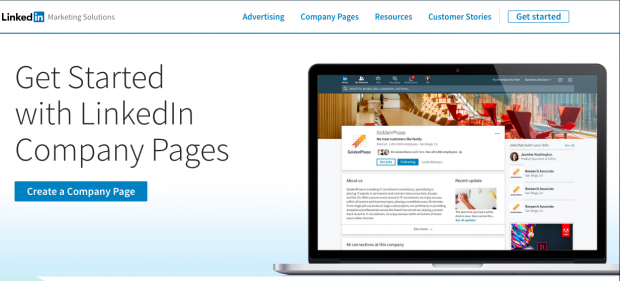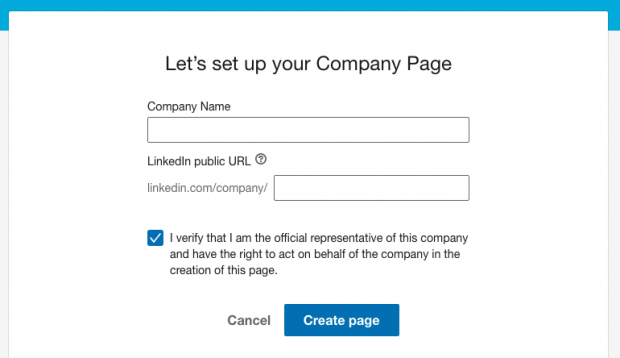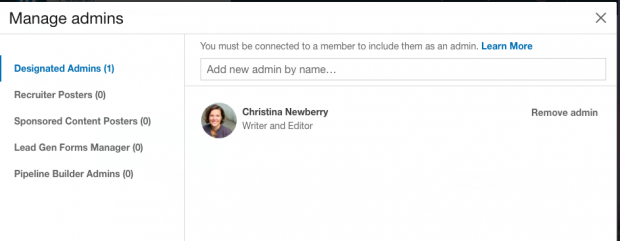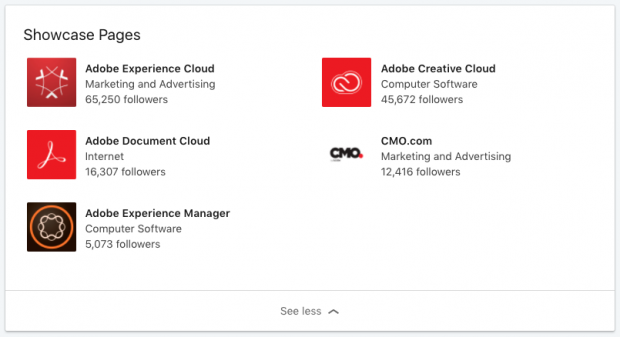
LinkedIn Marketing
With 562 million users, LinkedIn is all about building networks and connections. It’s not only about who you know, but about who your connections know.
That’s the real power of LinkedIn for business: the ability to tap into existing connections and grow your brand through word-of-mouth. It’s also the top-rated social network for lead generation.
If your LinkedIn marketing strategy is limited to a personal profile—especially one with an out-of-date, bare-bones resume—it’s time to up your game. You need a detailed Company Page if you want to grow your audience and drive business results.
In fact, according to insights provided to Hootsuite from LinkedIn, completed Company Pages generally receive twice as many visitors than those with incomplete pages. And organizations that post at least monthly generally gain followers six times faster than those that don’t.
Read on to learn how to create a winning LinkedIn strategy for your business.
How to set up a LinkedIn Company Page
A Company Page helps LinkedIn members learn about your business, your brand, and job opportunities with your company. Company Pages are also a great way to establish industry expertise. For example, Hootsuite’s LinkedIn page has more than 190,000 followers tuned in to the valuable and timely content we share—and that’s not including the 1.3 million people that follow CEO Ryan Holmes’ thought leadership articles.

LinkedIn Company Pages used to be viewed primarily as HR landing pages for brands. Though this is still one way to use LinkedIn, the network is also becoming the perfect place to drive business results, raise brand awareness, promote career opportunities, and educate potential customers on your products and services. Rich content and compelling status updates can help to establish your brand as a leader in your industry.
Here’s how to set up a LinkedIn Company Page for your business. Note that if you don’t have an existing personal LinkedIn profile, you’ll need to set one up before creating a page for your company. If you don’t have a LinkedIn profile yet, set one up by following our detailed instructions and return to this post once you’re done.
Step 1. Add your company
Head to the LinkedIn Marketing Solutions portal for creating Company Pages and click the big blue Create a Company Page button.

Enter your official company name and choose the URL that people will use to find your business on LinkedIn. You can’t change this URL later, so choose wisely. Click the box indicating that you have the right to act on behalf of your company, then click Create page.

LinkedIn automatically creates the shell of your Company Page. All you have to do is start filling in the details. In the welcome pop-up box, click Get Started.
Step 2. Add a cover image and logo
Choose a cover image to capture the feel of your business. The image should be 1536 x 768 pixels.
Since LinkedIn is a professional network, your company logo takes the place of your profile picture on other social networks. Your logo also appears on your employees’ LinkedIn profiles. Use a square logo sized to 300 x 300 pixels.
Don’t skip this step! LinkedIn data shows that companies with logos get six times more traffic to their Company Pages.
Step 3. Create a company description
You have 2,000 characters to describe what your company does, and why potential followers should care. This is important text, so get your marketing and content teams involved in crafting your messaging.
The first 156 characters are especially important, as that’s what will appear in the Google preview of your company page.
Underneath your company description, you can add up to 20 company specialties. These act as tags or keywords that will help people find your business on LinkedIn, so don’t skip this detail. Make sure your company’s various products, services, and strengths are well represented here.
Not sure what you should include? Try some social listening to get a sense of what words people are already using to talk about you and your industry online. Think about this from your customers’ point of view.

Step 4. Fill in your company details
Enter your business website URL. You’ll then provide your company details using several drop-down menus that indicate your industry, company size, and company type (public, non-profit, educational, and so on), and enter the year your company was founded.
You’ll also need to provide at least one location for your business.
If you already belong to some relevant LinkedIn Groups that you’d like to feature on your company page, you can enter them in the appropriate section here. Otherwise, you can leave this field blank for now.
Step 5. Publish your page
Click the Publish button and your Company Page will go live.
Before going any further, click the Go to member view button at the top right of the page to see what your Company Page looks like to others. If you’re happy with your page, great! If not, click Manage page and make any tweaks necessary to get it looking just right.
Step 6. Add page administrators
You don’t need to be in this alone. LinkedIn allows you to choose which employees can administer your page.
To add team members, click the Me icon at the top of your LinkedIn Page, then choose your company page under the Manage section.
Click Admin tools at the top right, then select Page admins. Add your team members by name. You must already be connected with them on LinkedIn to add them as page administrators.

Click Save changes to finish setting up your team.
Step 7. Optimize, optimize, optimize
Now that you’ve set up your LinkedIn Company Page, it’s time to make sure it’s performing at its full potential. A few quick polishes, summarized in the video below, will ensure your Company Page follows best practices and looks as professional as possible.
How to create a LinkedIn marketing strategy
Setting up a company page is simple—but don’t let that lull you into slapping something together without a LinkedIn for business strategy to maximize your page’s benefits. Rather than simply racking up followers and connections, think about how you can use LinkedIn marketing tools to uncover new opportunities to grow.
Start by developing SMART goals. After all, you’ll never know whether you achieve your goals if you don’t take the time to set goals in the first place. LinkedIn can support businesses in many ways, so you need to determine exactly what you want to get out of your LinkedIn business efforts. Are you trying to build a network for social selling? Establish yourself as a thought leader? Recruit top talent in your field?
Whether you want to tackle all of these aspects or focus on only one, you need to create goals to help you work toward a target, then understand how your efforts are paying off. SMART goals are specific, measurable, attainable, relevant, and time-bound.
Keep in mind that even if you’re new to using LinkedIn for business, you can gain a lot of useful intelligence for goal-setting and strategic planning by examining who’s already connecting with you—and how—on your other social channels.
If you haven’t yet developed audience personas, this is a great time to do so, as knowing who you’re trying to target is key to crafting the right message. If you’re using LinkedIn for recruiting, be sure to consider employees’ and candidates’ needs as well.
LinkedIn for business: tips and ideas
Just because you build a Company Page doesn’t mean that followers will come. You can boost your chances of success with the following LinkedIn for business tips and strategies.
1. Encourage your employees to connect with your company’s LinkedIn Page
Your colleagues and employees are your best resources to start growing an audience: according to LinkedIn, employees have on average 10 times more first-degree connections than a company has followers, and companies with a strong employee advocacy program in place are 58 percent more likely to attract top talent—and 20 percent more likely to retain them.
Employees are your biggest advocates, and by adding them as followers you also tap into each of their networks, expanding your reach tremendously. Encourage employees to add their position at your company to their LinkedIn profiles. Your Company Page will then be linked from their profiles, and their profiles will in turn appear on your Company Page.
2. Publish valuable content
The best way to grow your audience and keep your followers is to provide them with value by posting articles or company updates on a regular basis: LinkedIn recommends at least once per weekday. In addition to appearing on your Company Page, your posts appear in each of your followers’ news feeds.
If you know of a blog post or a news article from an external source that would benefit your followers, you can share that, too. Even if the content doesn’t originate from your team, it will show that you have your ear to the ground in your industry. This can also help foster important connections with other thought leaders. Be sure to provide value and context to your post when sharing—don’t just copy-and-paste the URL.
To share more in-depth expertise, try publishing articles on the LinkedIn publishing platform. Rather than sharing content from other networks or your website, you can create and publish articles within the LinkedIn ecosystem. You can’t publish articles directly from your Company Page, but the leadership team or key faces at your company can publish articles from their LinkedIn profiles and can help boost your company’s presence on the network.
Make sure you’re familiar with practices for sharing content on LinkedIn, outlined in the video below, before getting started.
3. Include rich media
Yes, LinkedIn is business-first, but you still need to make your content stand out from the crowd—and text-only posts are not the way to do that. LinkedIn figures show that posts with an image included get 98 percent more comments.
If you have a YouTube channel, try linking to your videos from LinkedIn. While other social channels require you to upload native videos for autoplay, on LinkedIn, YouTube videos play automatically in the news feed, and can generate a 75 percent higher share rate.
4. Take advantage of LinkedIn Groups
Being an active participant in a LinkedIn Group can help you and your business network with other professionals and businesses in your field, especially those outside of your immediate circle of current and present colleagues, classmates, and employers. Participating in a Group discussion will also attract views to your Company Page.
To find a group with interests that align with your business goals, use the search feature at the top of your LinkedIn homepage or check out LinkedIn’s suggestions with Groups discover. You can also create a new Group based on whatever topic or industry you’d like.
If you belong to an association, check to see if it has a members-only LinkedIn Group, which can be a valuable source of professional networking and development. The American Institute of CPAs, for instance, sponsors a LinkedIn Group with more than 69,000 members, where in-depth professional conversations can continue for months.

If you create a group or join a group that you want to showcase, you can add it as a featured group on your company page. To do so, click the Me icon at the top of your LinkedIn Page, then choose your company page under the Manage section.
Select the Overview tab from the top menu, then scroll down to Featured groups. Start typing in the name of your group and it should auto-complete. You can add up to three featured groups to your company page.
5. Try Showcase Pages
Showcase Pages function like subdomains of your Company Page, allowing you to spotlight specific areas of your business, like a particular brand or ongoing initiative.
LinkedIn members can choose to follow one or more of your Spotlight Pages if they’re particularly interested in a specific aspect of your company. You can create up to 10 Showcase Pages by default. If you need more, you’ll need to submit a support request to LinkedIn.
To create a Showcase page, click the Me icon at the top of your LinkedIn Page, then choose your company page under the Manage section.
Bonus: Download a free guide to discover four time-saving tools to help you grow your LinkedIn network faster. Includes one tool that lets you schedule a week’s worth of LinkedIn updates in just three minutes.
Get the free guide right now!
Click Admin tools at the top right, then select Create a Showcase Page.
Adobe, for example, has Showcase Pages for five of its products, all targeted to different audiences.

While the main Adobe LinkedIn Company Page has 887,000 followers, the Showcase Pages have follower counts ranging between 5,000 and 64,000. Those are much smaller numbers, but the Showcase Page followers are getting updates and information about the specific elements of the Adobe portfolio that they’re interested in—so these are valuable relationships to foster.
6. Go global with multi-language tools
If you have customers—or want to have customers—in countries where English is not the primary language, you can create custom descriptions of your company in 20 different languages. The appropriate description will appear for each LinkedIn member based on the language settings they have chosen to use when viewing the network. You can set your company name to appear in these languages as well.
When you publish content and updates, you can post in different languages and configure the settings so that your global followers see your content in their chosen language. This is a great way to build credibility with LinkedIn’s international members and show that you care about working with them in a way that puts their needs first.
7. Understand the LinkedIn algorithm
While most other social networks keep their algorithm secrets closely guarded, LinkedIn provides quite a bit of information about how its algorithm works. Here’s how the algorithm rates and ranks your content, in a nutshell.
1. A bot evaluates your content as spam, low-quality, or clear. The takeaway? Quality is important, as you obviously want to aim for the clear ranking here.
2. The algorithm measures initial user engagement. Is your post getting likes and shares? Good. Are users hiding it from their feeds or marking it as spam? Whoops, not so good. Again, quality is key, but so is relevance. Make sure your posts speak to your followers, giving them reasons to engage with rather than hide your content.
3. The algorithm does some further checks for spam and credibility based on the quality of your account and your network. Engagement is also very important in this stage.
4. Human editors review content and determine whether it should continue to be displayed, or even boosted.
Of course, it’s not always quite that simple. For more details and strategies for making the most of the LinkedIn algorithm, check out our post How the LinkedIn Algorithm Works (And How to Make it Work for You).
8. Incorporate LinkedIn ads
LinkedIn members provide the network with detailed information about their professional interests, associations, and skills. That means LinkedIn has exceptional targeting capabilities, allowing you to make laser-focused strategic decisions about incorporating LinkedIn ads into your social media marketing strategy.
LinkedIn offers several different self-service advertising solutions. Here’s a quick overview:
- Sponsored content: Amplify your content to reach a wider audience than you could organically and draw new eyeballs to your Company Page.
- Text Ads: These are pay-per-click or CPM ads that appear on the LinkedIn homepage, profile pages, Groups pages, search results pages, and more.
- Sponsored InMail: Similar to email marketing, but within the LinkedIn ecosystem. Sponsored InMail allows you to send personalized ads to LinkedIn members’ inboxes. Messages are only delivered when members are active on LinkedIn, making them likely to be noticed.
Utah State University’s Jon M. Huntsman School of Business used LinkedIn Sponsored InMail ads as part of a campaign to attract qualified candidates to its MBA program. Using precise targeting, Utah State achieved a 27.5 percent open rate on its Sponsored InMail messages and a 71 percent conversion rate for requests for information.
These are just the self-serve ad options. LinkedIn also offers advertising products that you can purchase through an ad platform, or through a LinkedIn marketing partner. You can find all the details in our Guide to LinkedIn Ads.
9. Learn from LinkedIn Analytics
LinkedIn’s research shows that posts tend to get the most engagement in the morning, followed by posts published after business hours. This is a good starting point when planning your publishing schedule, but what works for the average business may not work best for yours.
Fortunately, LinkedIn offers detailed analytics to help you learn what kind of content your followers are most likely to engage with, understand your follower demographics, and track traffic and activity on your company page.
Here’s how to access LinkedIn Analytics for your Company Page:
Click the Me icon at the top of your LinkedIn Page, then choose your company page under the Manage section. Click the Analytics tab and choose Visitors, Updates, or Followers.
Tracking who is visiting your Company Page—and how they interact with your content once they get there—will allow you to tweak your LinkedIn for business strategy based on real data, maximizing the effectiveness of this important business social network.
For more details on LinkedIn Analytics, visit our LinkedIn Analytics Guide for Marketers.
For more key ways to take advantage of LinkedIn for business, check out our post on how to give your business a LinkedIn makeover. The tips are hugely valuable even if you’re just starting out using LinkedIn for business purposes.
Above all, remember that LinkedIn is a professional network that allows you to build credibility, create a meaningful network, and glean insider expertise from established experts in your industry. It’s a valuable tool in your social marketing arsenal, so make sure you’re using every opportunity it provides.
